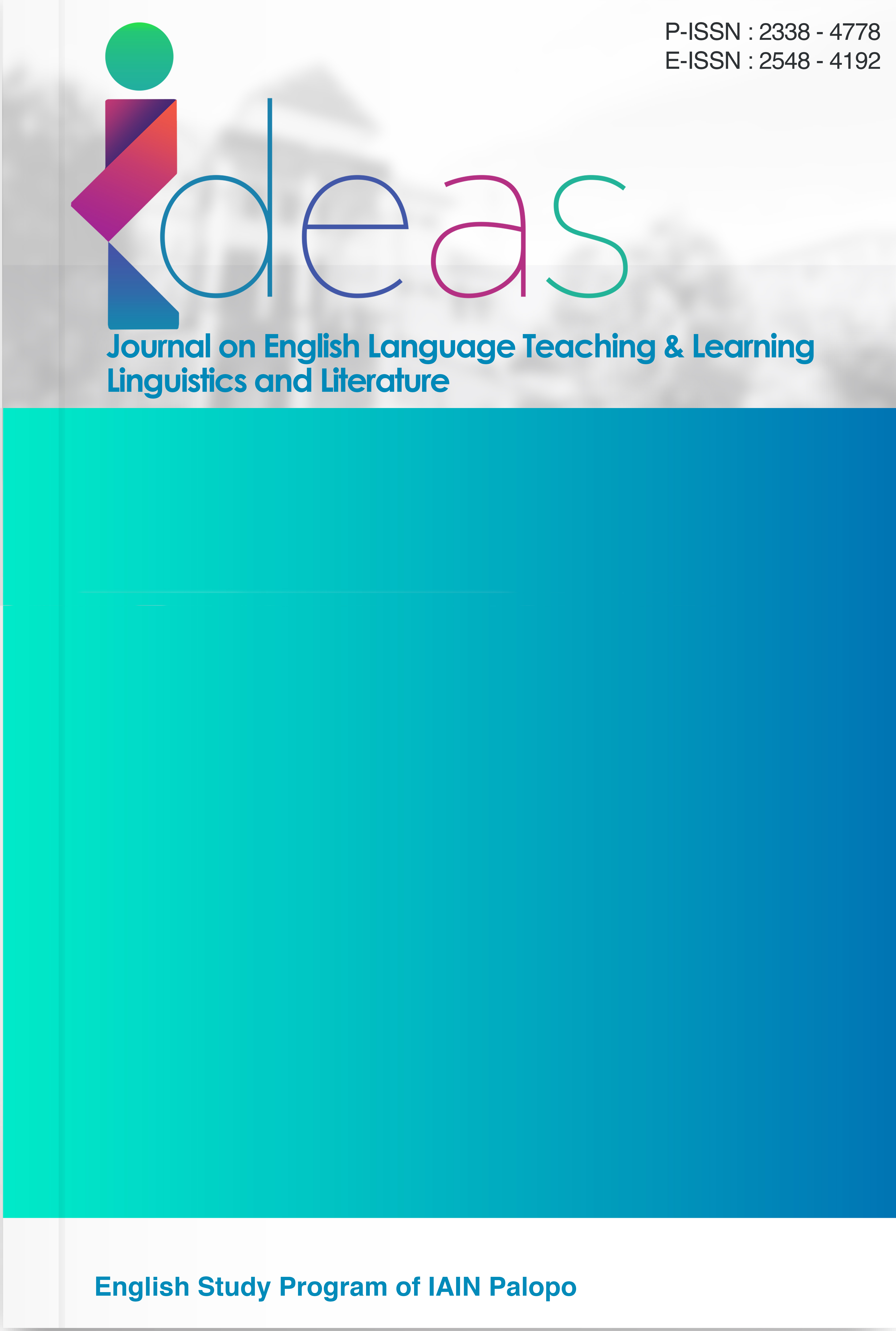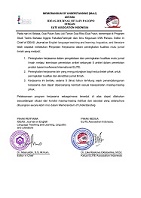Exploring Boarding School EFL Teachers' Strategies to Build Up Students' Speaking Competence
DOI:
https://doi.org/10.24256/ideas.v13i2.7860Keywords:
boarding school, case study, communicative language teaching, qualitative research, speaking competence, teaching strategiesAbstract
This study investigates how EFL (English as a Foreign Language) teachers utilize teaching strategies to enhance students' speaking competence, particularly in Grade 8 classes. The data were collected through 30-minute observations per teacher and 15-minute semi-structured interviews with both teachers from the boarding school, conducted both inside and outside the classroom. This study employed a descriptive case study approach, and the data were analyzed using descriptive qualitative analysis to identify recurring patterns and categorize the strategies used in the classroom. The findings revealed that teachers employed a combination of strategies both inside and outside the classroom. Inside the classroom, strategies include vocabulary drilling, question-and-answer sessions, discussions, and group work. Meanwhile, the teachers from outside the classroom employed a range of teaching strategies, including group work, vocabulary drilling and memorization, as well as question-and-answer sessions and conversations. The above strategies demonstrate that interaction strategies, such as dialogue, conversation, and Q&A, encourage the use of speaking language, while vocabulary drilling provides the foundation for speaking development. The results offer insight into how boarding schools can promote lifelong language learning by striking a balance between classroom instruction and additional practice. The study highlights the practical value of interactive strategies in fostering speaking competence. However, as the research was limited to two teachers in a single institution, the findings provide transferable insights for similar EFL boarding school settings, particularly in highlighting the practical value of interactive approaches for fostering speaking competence.
References
Akhter, S. (2021). Exploring the significance of speaking skill for EFL learners. Sir Syed Journal of Education & Social Research, 4(3).
Creswell, J. W. (2013). Qualitative inquiry and research design: Choosing among five approaches (2nd ed.). Sage.
De Jong, N. H., Steinel, M. P., Florijn, A. F., Schoonen, R., & Hulstijn, J. H. (2012). Facets of speaking proficiency. Studies in Second Language Acquisition, 34(1), 5–34. https://doi.org/10.1017/S0272263111000489
Hanif, N. P. (2023). An analysis of teacher’s strategy in teaching speaking skills in the class at SMA Negeri 1 Seputih Banyak in the first semester of academic year 2022/2023. UIN Raden Intan Lampung.
Harmer, J. (2015). The practice of English language teaching (5th ed.). Pearson Education Limited.
Kazemi, E. (2018). The effect of vocabulary size in oral productions on the speaking proficiency of EFL learners. Global Journal of Foreign Language Teaching, 7(4), 150–154. https://doi.org/10.18844/gjflt.v7i4.3003
Koizumi, R., & In’nami, Y. (2013). Vocabulary knowledge and speaking proficiency among second language learners from novice to intermediate levels. Journal of Language Teaching and Research, 4(5), 900–913. https://doi.org/10.4304/jltr.4.5.900-913
Mislina. (2023). Teachers’ strategies in teaching speaking for young learners. Universitas Islam Negeri K.H. Abdurrahman Wahid Pekalongan.
Moses, D. A., Leonard, M. K., Makin, J. G., & Chang, E. F. (2019). Real-time decoding of question-and-answer speech dialogue using human cortical activity. Nature Communications, 10(1), 3096. https://doi.org/10.1038/s41467-019-10994-4
Madehang, M., Masruddin, M., & Iksan, M. (2024). Reflecting on the Implementation of Online English Learning in Islamic Higher Education: Lecturers and Students’ Perspectives. International Journal of Asian Education, 5(3), 183-197.
Nation, I. S. P. (2013). Learning vocabulary in another language (2nd ed.). Cambridge University Press. https://doi.org/10.1017/CBO9781139858656
Richards, J. C., & Rodgers, T. S. (2014). Approaches and methods in language teaching (3rd ed.). Cambridge University Press.
Sadoughi, M., & Hejazi, S. Y. (2021). Teacher support and academic engagement among EFL learners: The role of positive academic emotions. Studies in Educational Evaluation, 70, 101060. https://doi.org/10.1016/j.stueduc.2021.101060
Sadoughi, M., & Hejazi, S. Y. (2023). Teacher support, growth language mindset, and academic engagement: The mediating role of L2 grit. Studies in Educational Evaluation, 77, 101251. https://doi.org/10.1016/j.stueduc.2023.101251
Suryanto, B. T., Imron, A. A., & Prasetyo, D. A. R. (2021). The correlation between students’ vocabulary mastery and speaking skill. International Journal of English Education and Linguistics (IJoEEL), 3(1), 10–19. https://doi.org/10.33650/ijoeel.v3i1.2042
Tong, Y., Hasim, Z., & Abdul Halim, H. (2022). The impact of L2 vocabulary knowledge on language fluency. Pertanika Journal of Social Sciences and Humanities, 30(4), 1723–1751. https://doi.org/10.47836/pjssh.30.4.14
Wahidiyati, A., Nuroh, E. Z., Taufiq, W., & Ruzieva, M. Y. (2024). Teaching strategies in speaking class in junior high school (pp. 362–376). https://doi.org/10.2991/978-2-38476-247-7_40
Winurini, S. (2019). Perbedaan kesejahteraan siswa pada SMA Negeri asrama dan bukan asrama di Kota Malang. Aspirasi: Jurnal Masalah-Masalah Sosial, 9(2), 274–288. https://doi.org/10.46807/aspirasi.v9i2.1105
Yin, R. K. (2009). Case study research: Design and methods. Sage.
Zhu, F., Lei, W., Wang, C., Zheng, J., Poria, S., & Chua, T.-S. (2021). Retrieving and reading: A comprehensive survey on open-domain question answering. ArXiv Preprint ArXiv:2101.00774.
Downloads
Published
Issue
Section
Citation Check
License
Copyright (c) 2025 Hafez Al Assad, Farida Repelita Waty Br. Kembaren, Muhammad Dalimunte

This work is licensed under a Creative Commons Attribution-ShareAlike 4.0 International License.
Authors retain copyright and grant the journal right of first publication with the work simultaneously licensed under an Attribution-ShareAlike 4.0 International (CC BY-SA 4.0) that allows others to share the work with an acknowledgement of the work's authorship and initial publication in this journal.
Authors are able to enter into separate, additional contractual arrangements for the non-exclusive distribution of the journal's published version of the work (e.g., post it to an institutional repository or publish it in a book), with an acknowledgement of its initial publication in this journal.
Authors are permitted and encouraged to post their work online (e.g., in institutional repositories or on their website) prior to and during the submission process, as it can lead to productive exchanges, as well as earlier and greater citation of published work (See the Effect of Open Access)




